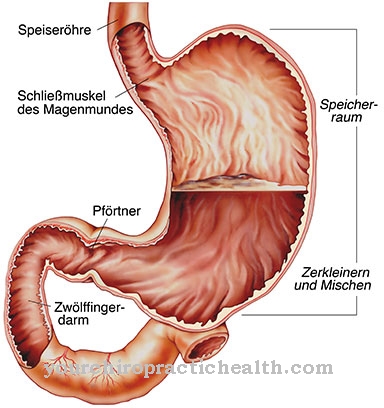The disease Progeria type 2, also Werner syndrome called, belongs to the genetic defects. The word progeria comes from Latin and means "premature aging". The Werner syndrome was first discovered by the Kiel doctor C.W. Otto Werner described in 1904.
What is progeria type 2?
.jpg)
© Jezper - stock.adobe.com
The genetic error in the genome occurs very rarely. If a person is affected by Werner syndrome, premature aging occurs, with the patient having a life expectancy of around fifty years.
In contrast to the more well-known type 1 progeria, type 2 does not appear in childhood, but only in adulthood. With progeria type 2, there are not only premature external factors of the aging process, but also age-related diseases and side effects.
causes
The cause of premature aging lies in the DNA, more precisely on the short arm of chromosome 8, whereby the RECQL1 gene is mutated. The DNA, which is located as a kind of tangle in the cell nucleus, is deficient in helicase, a special protein.
In order to carry out its normal functions, the DNA has to be unwound, which the DNA helicase is responsible for. Due to the disturbance that occurs, the DNA is incorrectly converted during replication, which leads to developmental disorders and accompanying diseases. The DNA helicase is also responsible for removing defects in the DNA, which increases the risk of cancer if a defect is present.
This special protein also protects the telomores of the chromosomes, i.e. the ends of the DNA, from premature degradation. In type 2 progeria, these are broken down by the defect, which means that the cell can no longer divide. This reduces the frequency of cell division and increases cell aging due to the low cell division.
Symptoms, ailments & signs
The symptoms of this disease only show up in adulthood. The growth spurt that is common in puberty does not take place. Instead, from this point onwards the signs of premature aging will gradually become apparent. At the age of 20 the hair is already gray; they often look sparse and thin. Those affected grew much smaller than their peers.
They often have flat feet. The face is narrow while the eyes look relatively large. As the fatty tissue under the skin breaks down like it does in older people, the skin appears thinner and more translucent. It can be wrinkled or stretched across the bone. As the disease progresses, age spots appear and the skin becomes more horny.
For many of those affected, the voice changes. It sounds high, thin and rather weak. Most of the patients are sterile as the function of the gonads is also restricted. As a side effect of premature aging, there are usually other diseases.
Osteoporosis can occur, which is associated with increased bone fractures. Cataracts, diabetes mellitus or arteriosclerosis are also possible. The latter can lead to a stroke or heart attack. The risk of developing tumors is increased. Melanoma is the most common. The life expectancy of those affected by Werner Syndrome is shortened.
Diagnosis & course
The first symptoms usually appear in puberty, as this is where the usual growth spurt ceases. Childhood, on the other hand, has no further signs. The body of those affected changes quickly, so that they look unusually old by the age of 30 to 40. Typically progeria type 2 is noticeable because patients develop a mostly bird-like face and a weak, squeaky voice.
The skin changes particularly strongly due to the severely restricted cell division. It becomes thin and wrinkled and often has heavy pigmentation.The sub-fatty tissue of the skin is partially reduced, so that the skin becomes firm and the body loses the important fat deposits. The hair will shake too. It turns gray quickly and loses its natural density and thickness.
The Werner syndrome also causes many age-related diseases and comorbidities. Those affected have a greatly increased risk of cancer, since the DNA helicase no longer corrects the errors in the genetic material. This often leads to mutations and thus to tumor diseases. They also often suffer from diabetes mellitus, the typical age-related diabetes, and eye diseases such as cataracts.
The progressive muscle wasting quickly becomes visible. Due to progeria type 2, those affected also suffer from osteoporosis, where they often suffer bone fractures. Even the smallest loads can lead to fractures due to the increasing loss of bone density and increasing porosity. Atherosclerosis occurs very often in Werner syndrome, which results in an increased risk of stroke and heart attack. The weakness of the crayon glands, which can lead to infertility, is also a concomitant disease.
The brain and the central nervous system are not affected by the disease, so that no nerve cells perish and normal brain function is not impaired.
The diagnosis of progeria type 2 is usually based on the specific physical symptoms. A genetic test is done to confirm the diagnosis. Scientists assume that Werner syndrome is the basis of the so-called recessive inheritance. Both parents have to pass on the defective gene. However, this assumption has not yet been sufficiently clarified. It can be observed that type 2 progeria often occurs in relationship marriages.
Complications
People with progeria 2 have a genetic defect that leads to typical complications for them. In these people, the aging process sets in prematurely and accelerates, the skin becomes very wrinkled, the subcutaneous fat tissue recedes, and they tend to have gray, thinning hair from a young age. Even at the age of 30 to 40 they look like old people. There is something birdlike about her face and the voice is weak and squeaky.
As a result of the accelerated aging process, these patients suffer from diseases at a young age that normally only appear in old age, such as arteriosclerosis. This promotes heart attacks or strokes. In addition, your bone loss is faster and you suffer more from osteoporosis. Even with minor loads, you run the risk of breaking your bones.
There is also an increased risk of developing cancer. Other complications are diabetes mellitus and cataracts. People with progeria type 2 also suffer from a congenital weakness of the gonads, which leads to infertility. Due to the typical course of the disease, these people have a reduced life expectancy, which is around their mid-fifties.
When should you go to the doctor?
If parents or relatives notice that the offspring did not have a growth spurt during puberty, a doctor should be consulted. This circumstance is to be understood as an alarm signal of the organism and should be pursued further. If the person concerned ages prematurely, there is also cause for concern. A doctor should be consulted as soon as the complexion of an adult or old person develops in the young person. A doctor should be presented with age spots, unusual wrinkling and an aged appearance. Gray hair, thinning hair, or severe hair loss as a young person are considered uncommon.
A visit to the doctor is advisable so that an investigation into the cause can be initiated. A doctor is required if infertility is found or if there are changes in the voice. Often the voice is thin, quiet and not very powerful. The entire appearance of the person affected has a weak effect on the people in the immediate vicinity and is marked by life. If there are more and more broken bones, physical performance deteriorates rapidly, or if the person concerned complains of an internal weakness, action is required. A doctor should be consulted so that a treatment plan can be drawn up. If you feel generally unwell, feel sick or have unusual impairment of your usual vision, you should consult a doctor.
Treatment & Therapy
Affected by Progeria type 2 receive symptomatic therapy, as there is no cure for the genetic defect. The attending physicians try to alleviate the symptoms and prevent possible complications. It is primarily about ensuring the best possible quality of life for the patient and improving it as much as possible.
Doctors can treat diabetes mellitus symptomatically by learning how to change their diet and being treated with insulin. Due to the osteoporosis and the increased risk of bone fractures, the residential facility should be geared towards the patient.
Stumbling blocks such as exposed cables should be placed with care, ideally against the baseboards. Carpets should also be laid out and fixed without creases. In addition, the apartment should be well-lit due to the eye diseases that Werner syndrome patients suffer.
prevention
As it is with Progeria type 2 If it is a genetic defect, it is difficult to prevent. Scientists point out that this genetic defect is passed on via recessive inheritance. This means that both parents have to carry the defective gene in order to pass the disease on to their child. It can be observed that Werner syndrome often occurs in relationship marriages. If there is a suspicion that a parent may have the defective gene, a specific examination can clarify the situation.
Aftercare
Since type 2 progeria cannot be treated, there are no options for follow-up care in the traditional sense. However, affected patients should go to the doctor at regular intervals for an examination. In the course of progeria type 2, secondary diseases such as diabetes mellitus, clouding of the eyes or an unhealthy rise in cholesterol occur.
If these symptoms are recognized in time, appropriate treatment can be scheduled. Especially in the case of diabetes triggered by type 2 progeria, it is important that the patient is properly adjusted with medication. Otherwise, there is a risk that patients' blood sugar will rise too high or drop so low that they will go into sugar shock, which can be fatal.
An important goal, however, is to keep patients pain-free for as long as possible and to spare them strenuous or risky therapies. That is why doctors refrain, for example, from starting chemotherapy if they are diagnosed with cancer. The risk that progeria patients will not survive therapy is simply too high.
Treating pain and preventing possible complications are achieved through a combination of medication and lifestyle changes. In addition, the patients also receive psychological care in order to prevent the occurrence of mental illnesses such as depression.
You can do that yourself
Suffering from progeria type 2 is very stressful. Psychotherapeutic support is therefore recommended. In addition, the progeria should be treated symptomatically. This also includes regularly caring for the patient's thinner skin and protecting it from sunlight. Creams with a high sun protection factor are suitable for this. Because of the increased risk of bone fractures, the apartment should be furnished in such a way that the patient cannot trip and / or fall unnecessarily.
Patients with type 2 progeria are recommended to maintain a healthy lifestyle, for example to defy the increased risk of cancer. A healthy lifestyle includes, on the one hand, avoiding poisons of all kinds, such as nicotine, alcohol or pollutants from the environment. On the other hand, patients should get active, do sports and eat healthily. This diet can consist of light food, low fat and low sugar. In this way, diabetes mellitus can also be avoided.
Since eighty percent of all immune cells are located in the intestines, patients can also resort to probiotics. These are preparations such as yogurt or food supplements that contain living microorganisms. These microorganisms multiply in the intestine, where they help maintain the immune system. If the immune system is in tact, diseases can be warded off or their course can be alleviated.

.jpg)






















.jpg)



